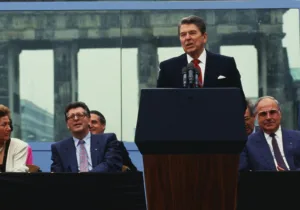Following on from last week’s post about the prospect of deterring both Russia and China from their more malevolent ambitions, the present proposal is that the US must commit to significantly increasing defense spending. The proposal is grounded in the assertion that doing so is feasible, on a practical level, because we are constrained from doing so by any dearth of resources. Fears that we have to choose between bread or bombs—that is, feeding the poor or funding our military—are unfounded.
To be sure, the purely economics argument is well outside my lane (full disclosure: I scored 14% on the math portion of the GRE – but, hey, that doubled my practice score so it was really kind of a win). I can also read well enough to grasp that there is disagreement as to how to measure GDP—and, by extension, how to measure US economic strength versus our adversaries. Matthew Kroenig takes a bullish stance and insists the US can presently afford to outspend Russia and China at the same time:
The United States possesses 24 percent of global GDP compared to a combined 19 percent in China and Russia. This year, the United States will spend $778 billion on defense compared to only $310 billion in Russia and China.
I know there are arguments to the contrary, but the majority opinion—among the reliable opinion-makers anyway—seems to stand with Kroenig. True, some of those who do also qualify their agreement with the caution that US economic superiority is unlikely to remain the case, even into the near future. That said, many of these and others will qualify this qualification by noting that it might actually remain the case. A good back-and-forth between Kroenig and Emma Ashford and on all this can be found here.
But whatever the truth of relative US economic strength, it remains a fact that the US both can spend more on defense and must spend more on defense. The US could double its defense spending and still remain beneath its Cold War average (close to 7% GDP). Given that the current geo-political climate is every bit as dangerous as the Cold War climate, the increase in spending is simply common sense.
On top of this, we ought to yoke (or cajole (or possibly coerce)) our allies to contribute more deeply to the defense of the free world—and, indeed, their own. Taken together, the US and its treaty allies and partners possess upwards of a walloping 60% of global GDP. But this shared strength can’t be taken for granted. A world in which the US abandons Ukraine in favor of a pivot to Asia is likely a world in which much of Europe falters in its responsibility to provide sufficiently for both Ukraine and its own security—as suggested by the general French and German instinct over recent years to placate rather than confront Russia. US leadership, properly calibrated, ought to shift from a model that too often appears to depend on the US defense of Europe to one in which US leadership of the transatlantic alliance serves as a key contributor to European self-defense, including through the continued provision of the nuclear umbrella, to overall vision, and coordination of that vision.
I also understand enough about economics to know that this isn’t a situation in which we can simply throw money around and walk away stronger and with the free world better defended. The US Defense Department—like any other—is a government bureaucracy. There’s going to be fraud, waste, abuse, and misdirected spending. We should fix that as best we can. Among much else, acquisitions should be tailored to the mission sets. If it’s right to assume that Europe will be primarily be the domain of land-based armies and the Pacific of sea power – with air power and new technologies heavily involved in both theaters – then it would make sense, broadly, for European allies to invest in armor, artillery, and air and new tech; while Asian allies focus on naval mines, harpoon missiles, surface and subsurface assets, and air and new tech. On the homeland, missile defense will require an infusion of cash, we’ll need to shore up our technological edge over our adversaries, and, crucially, we’ll need to upgrade and restructure our nuclear assets, and we’ll need to focus on rebuilding and streamlining the defense industrial base. On this last point, key industrial readiness indicators suggest we are going in the wrong direction. For instance, in 1985 there were 3 million workers in the defense industry. Now, it’s 1.1 million. While efficiencies have presumably increased since the 1980s, it’s pretty clear we’re still drastically underpowered. Experts point out that COVID demonstrated how vulnerable US supply chains are and the Ukraine conflict continues to demonstrate how high-intensity conflicts between peers is massively different than counterterrorism operations in the way it consumes military assets and munitions. Our support of Ukraine against Russia has revealed weaknesses in the U.S. defense industrial ecosystem. We should fix those too.
Pure economics aside, the philosophical arguments are plain. One might think back to 2015 and Russian incursions into Sweden’s sovereign territory to get a handle on what readiness requires. Back then, you might recall, Russian fighter bombers were indulging in a spate of flirting with and actively penetrating Swedish airspace. Further down the vertical, submarines, assuredly Russian, were provocatively prowling Sweden’s sovereign waters off Stockholm. This isn’t something that would so easily have happened in the Cold War. Then, Sweden’s navy was much more formidable presence in the Baltic. Comprising dozens of surface ships and submarines, their hunter assets were well-stocked with an array of torpedoes, anti-submarine grenades, depth charges, and some of the most capable air assets in the world. Their coastline was guarded by multiple artillery battalions secreted along a network of mountain hideaways; and their army, nourished by the Viking tradition of ledungen– a standing army supported by local defense forces of citizen-soldiers always at the ready – could mobilize hundreds of thousands of battle-ready men within hours.
Complacency following victory in the Cold War, naivety, and poor decisions conspired to hobble that capacity. An estimable military developed over centuries was dismantled in barely more than a decade. Some claim that by 2004 a mere 6% of Swedish combat units remained. Her air force was cut in half. The navy too. In 2013, General Sverker Göransson, Supreme Commander of Sweden’s military, was asked how good the Swedish military was. He reportedly answered, “We can defend ourselves against an attack against a localized target…for about a week.” One place, one week. And a couple years later Russian bombers were crowding Swedish airspace and Russian subs playing in the waters just off the beaches of Sweden’s major cities.
To whatever degree the present state of American military readiness—including the ability of our defense industrial ecosystem to support it—is comparable to Sweden’s state-of-affairs in 2015, the Christian realist should stand aghast in equal measure. No one should love spending money on instruments that break things and kill people. Much is often made by progressive American Christian brothers and sisters about the US spending more money on defense than the next however-many-countries combined. Christians will play the Cassandra against the manipulations of the Military Industrial Complex and fear those with vested interests in warmaking. Many point to Eisenhower’s “The Chance for Peace” speech in which he laments the opportunity costs of defense spending:
Every gun that is made, every warship launched, every rocket fired signifies, in the final sense, a theft from those who hunger and are not fed, those who are cold and are not clothed. This world in arms is not spending money alone. It is spending the sweat of its laborers, the genius of its scientists, the hopes of its children. The cost of one modern heavy bomber is this: a modern brick school in more than 30 cities. It is two electric power plants, each serving a town of 60,000 population. It is two fine, fully equipped hospitals. It is some fifty miles of concrete pavement. We pay for a single fighter plane with a half million bushels of wheat. We pay for a single destroyer with new homes that could have housed more than 8,000 people.
The cautions—and the lamentation—is not entirely misplaced. But we also have to remember that a nation, like a family, must budget for both its values and its responsibilities. These ought not be competing factors. Paul’s letter to the Roman church teaches us that the government bears the sword for specific reasons. God’s mandate for the sovereign power is that they maintain the human goods of justice, order, and peace, without which human flourishing cannot take place. Our responsibilities emerge from, rather than compete with, our values. Having spent too little money (or spent it unwisely) on her national defense, Sweden inadvertently abdicated this responsibility and is became reliant on the beneficence of others who spent sufficiently to protect her. Worse than this, Sweden’s martial weakness risked emboldening Russia and encouraging the ambitions of the worst of Russian leaders.
All this reminds us that strength is stabilizing. Those who quote Eisenhower’s speech need to remember that while he lamented that military expenditures took away from better things, he nevertheless understood that the spending had to happen. “A vital element in keeping the peace,” he said several years after his “Chance for Peace” address, “is our military establishment. Our arms must be mighty, ready for instant action, so that no potential aggressor may be tempted to risk his own destruction.” Eisenhower understood that peace in our world is best assured through strength – both of arms and the credible willingness to use them. Our defense budget is not, seen in the right way, about buying instruments that break things and kill people. It’s about buying the tools required for peacemaking. You can buy all the bread you want, but if you don’t have basic security and the rule of law, there will be nothing to prevent the rapacious taking it from you.
How a nation spends its treasure reflects where its heart is. The two-front fight that is hard upon us will require that we put our heart into it. For the sake of all that is good in the world. And lest we pay a far greater—and possibly unpayable—price for not doing so.







 Live in the DC area? Sign-up for Providence's in-person events list!
Live in the DC area? Sign-up for Providence's in-person events list!